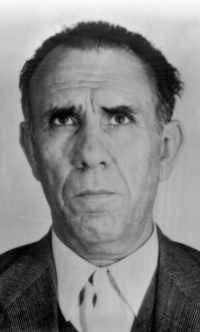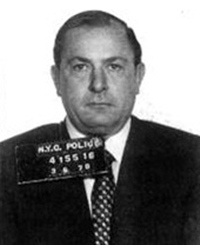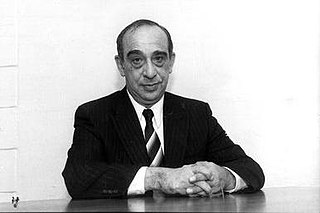Contents
This article needs additional citations for verification .(February 2024) |
| |||
|---|---|---|---|
| +... |

This article needs additional citations for verification .(February 2024) |
| |||
|---|---|---|---|
| +... |

| | This section is empty. You can help by adding to it. (July 2010) |
| | This section is empty. You can help by adding to it. (July 2010) |

Carlo Gambino was a Sicilian crime boss who was the leader and namesake of the Gambino crime family of New York City. Following the Apalachin Meeting in 1957, and the imprisonment of Vito Genovese in 1959, Gambino took over the Commission of the American Mafia and played a powerful role in organized crime until his death from a heart attack in 1976. During a criminal career that spanned over fifty years, Gambino served only twenty-two months in prison for a tax evasion charge in 1937.

Gaetano Badalamenti was a powerful member of the Sicilian Mafia. Don Tano Badalamenti was the capofamiglia of his hometown Cinisi, Sicily, and headed the Sicilian Mafia Commission in the 1970s. In 1987, he was sentenced in the United States to 45 years in federal prison for being one of the leaders in the "Pizza Connection", a $1.65 billion drug-trafficking ring that used pizzerias as fronts to distribute heroin from 1975 to 1984. He was also sentenced in Italy to life imprisonment in 2002 for the 1978 murder of Peppino Impastato.

Joseph Gallo, also known as "Crazy Joe", was an Italian-American mobster and Caporegime of the Colombo crime family of New York City, New York.

Joseph Anthony Colombo Sr. was the boss of the Colombo crime family, one of the Five Families of the American Mafia in New York City.

Giuseppe "Joe" Profaci was an Italian-American Cosa Nostra boss who was the founder of what became the Colombo crime family of New York City. Established in 1928, this was the last of the Five Families to be organized. He was the family's boss for over three decades.

Carmine John Persico Jr., also known as "Junior", "The Snake" and "Immortal", was an American mobster and the longtime boss of the Colombo crime family in New York City from 1973 until his death in 2019. He had been serving 32 years in federal prison from 1987 until his death on March 7, 2019.
The Colombo crime family is an Italian-American Mafia crime family and the youngest of the "Five Families" that dominate organized crime activities in New York City within the criminal organization known as the American Mafia. It was during Lucky Luciano's organization of the American Mafia after the Castellammarese War, following the assassinations of "Joe the Boss" Masseria and Salvatore Maranzano, that the gang run by Joseph Profaci became recognized as the Profaci crime family.

Joseph Magliocco, also known as "Joe Malayak" and "Joe Evil Eye", was a Sicilian-born New York mobster and the boss of the Profaci crime family from 1962 to 1963. In 1963, Magliocco participated in an audacious attempt with Joseph Bonnano to kill other family bosses and take over the Mafia Commission. The attempt failed, and, while his life was spared, he was forced into retirement. Soon after, he died of a heart attack on December 28, 1963.
Salvatore "Ciaschiteddu" Greco was a powerful mafioso and boss of the Sicilian Mafia in Ciaculli, an outlying suburb of Palermo famous for its citrus fruit groves, where he was born. His nickname, "Ciaschiteddu" or "Cicchiteddu", translates from the Sicilian alternatively as "little bird" or as "little wine jug".

Michele Cavataio, also known as Il cobra was an Italian mobster and powerful member of the Sicilian Mafia. He was the boss of the Acquasanta mandamento in Palermo and was a member of the first Sicilian Mafia Commission. Some sources spell his surname as Cavatajo.
The 1960s Sicilian Mafia trials took place at the end of that decade in response to a rise in organized crime violence around the late 1950s and early 1960s. There were three major trials, each featuring multiple defendants, that saw hundreds of alleged Mafiosi on trial for dozens of crimes. From the authority's point of view, they were a failure; very few defendants were convicted, although later trials as well as information from pentiti confirmed most of those acquitted were Mafiosi members, and were guilty of many crimes including some of those they were acquitted of.
The Commission is the governing body of the American Mafia, formed in 1931 by Charles "Lucky" Luciano following the Castellammarese War. The Commission replaced the title of capo di tutti i capi, held by Salvatore Maranzano before his murder, with a ruling committee that consists of the bosses of the Five Families of New York City, as well as the bosses of the Chicago Outfit and, at various times, the leaders of smaller families, such as Buffalo, Philadelphia, Detroit, and others. The purpose of the Commission was to oversee all Mafia activities in the United States and serve to mediate conflicts among families.
Albert "Kid Blast" Gallo, Jr. is an American mobster of the Genovese crime family.
Frank "Punchy" Illiano was a Brooklyn Captain with the Genovese crime family. During the 1960s and 1970s, he served as a top lieutenant to the Gallo brothers in their two wars with the Colombo crime family leadership.
Salvatore Greco, also known as "l'ingegnere" or "Totò il lungo", was an Italian criminal and member of the Sicilian Mafia. He was born in Ciaculli, as the son of Pietro Greco, who was killed during a bloody internal feud between the factions of the Greco Mafia clan in Ciaculli and Croceverde Giardini in 1946. His cousin Salvatore Greco "Ciaschiteddu" was the first ‘secretary’ of the Sicilian Mafia Commission.

The Greco Mafia family is historically one of the most influential Mafia clans in Sicily, from the late 19th century. The extended family ruled both in Ciaculli and Croceverde Giardini, two south-eastern outskirts of Palermo in the citrus growing area. Members of the family were important figures in the Sicilian Cosa Nostra. Salvatore "Ciaschiteddu" Greco was the first ‘secretary’ of the Sicilian Mafia Commission, while Michele Greco, also known as The Pope, was one of his successors.
The Ciaculli massacre on 30 June 1963 was caused by a car bomb that exploded in Ciaculli, an outlying suburb of Palermo, killing seven police and military officers sent to defuse it after an anonymous phone call. The bomb was intended for Salvatore "Ciaschiteddu" Greco, head of the Sicilian Mafia Commission and the boss of the Ciaculli Mafia family. Mafia boss Pietro Torretta was considered to be the man behind the bomb attack.
This is a list of organized crime in the 1950s, arranged chronologically.